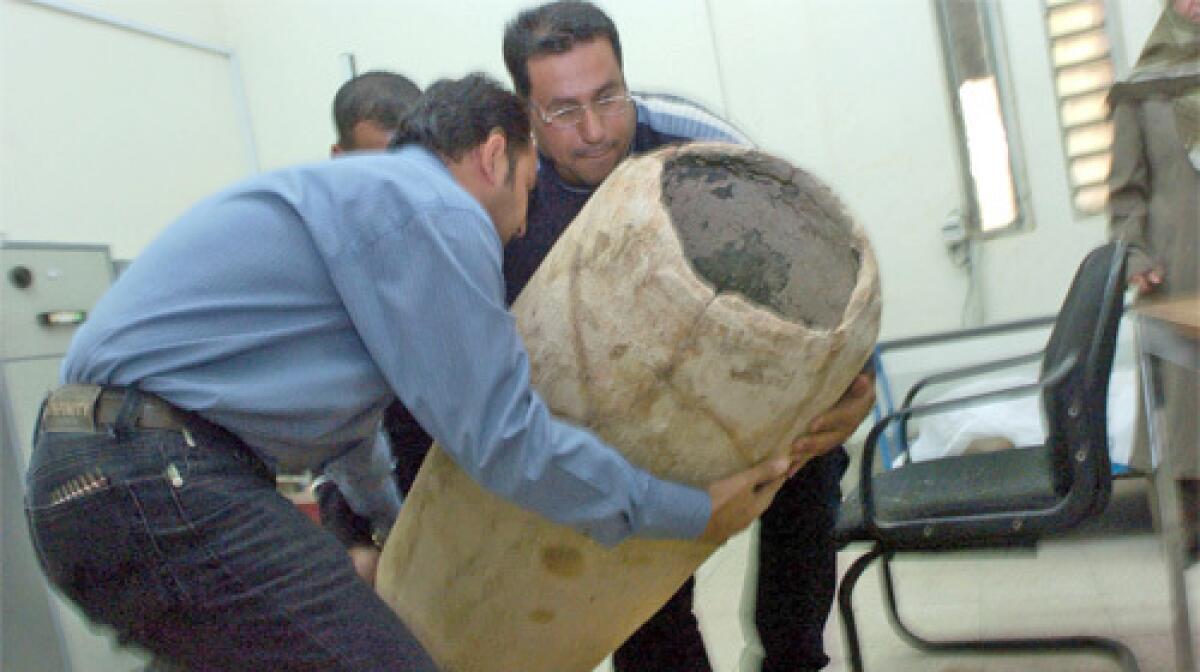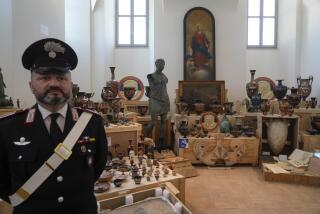From the Archives: Illegal diggers chipping away at Iraq’s heritage

Officials at Iraq’s National Museum receive recently recovered artifacts.
Reporting from BAGHDAD — He works as a blacksmith in one of Baghdad’s swarming Shiite slums. But at least once a month, Abu Saif tucks a pistol into his belt, hops into a minibus taxi and speeds south.
His goal: to unearth ancient treasures from thousands of archaeological sites scattered across southern Iraq.
Images of Baghdad’s ransacked National Museum, custodian of a collection dating back to the beginning of civilization, provoked an international outcry in the early days of the war in 2003.
The ancient statues, intricately carved stone panels, delicate earthenware and glittering gold are now protected by locked gates and heavily armed guards. But U.S. and Iraqi experts say a tragedy on an even greater scale continues to unfold at more than 12,000 largely unguarded sites where illegal diggers like Abu Saif are chipping away at Iraq’s heritage.
“It may well be that more stuff has come out of the sites than was ever in the Iraqi museum,” said Elizabeth Stone, an archaeology professor at the State University of New York at Stony Brook.
Iraqi officials say the U.S. government has supported their efforts to retrieve looted antiquities from the Sumerian, Babylonian, Assyrian, Islamic and other civilizations, but they do not hide their bitterness that more was not done to secure them in the first place.
“Iraq floats over two seas; one is oil and the other is antiquities,” said Abdul Zahra Talaqani, media director for Iraq’s Ministry of State for Tourism and Archaeology. “The American forces, when they entered, they protected all the oil wells and the Ministry of Oil . . . but the American forces paid no attention to Iraq’s heritage.”
The thefts were already taking place before the U.S.-led invasion in March 2003, but U.S. and Iraqi experts say they surged in the ensuing chaos.
Abu Saif, a man in his mid-30s with dark eyes, calloused hands and a long, black coat, was 14 when relatives introduced him to the hunt for buried treasure. Asked why he does it, he grins.
“For the thrill of it,” he said.
In the beginning, he was a lookout for others. Now, he has his own tightknit group of four or five diggers. He collects tips from farmers about possible archaeological sites and researches them in his small collection of dogeared books before traveling inconspicuously to meet his team and excavate. They work quickly, finishing a job in two to three days.
If they are successful, which they usually are, he shares the find with his diggers and the property owner. He considers what he does a hobby and says he sells only what he needs to cover costs. But he is vague about who the buyers are.
Talaqani says criminal gangs buy artifacts from men like Abu Saif and smuggle them out of the country. U.S. officials also suspect that Sunni and Shiite paramilitary groups may be taking a cut.
Abu Saif, who asked to be identified by a traditional nickname, admits that he once paid members of a Shiite militia to protect a site where he was digging. But a few hours later, another group of gunmen turned up and demanded more money. Now, he says, he refuses to deal with the militias.
He avoids the more famous sites such as the ancient cities of Isin, Shurnpak and Umma because “there are eyes upon them.” But he says there are plenty of out-of-the-way places near Kut and Nasiriya that yield small treasures. The artifacts include coins, jewelry and fragile clay tablets etched in wedge-like cuneiform script, recording myths, decrees, business transactions and other details of Mesopotamian life.
At his two-story cinder-block home, he pulls out old jewelry boxes and rummages through spools of thread to find ancient gems of agate and carnelian. His most treasured possession is a thumb-sized cylinder with a man’s face carved into one side and a woman’s face into the other. An appraiser told him it was from Babylonian times and was worth as much as $4,000. Asked whether he planned to sell it, he looked horrified and said, “No, these are my children!”
Stone has been tracing the thefts at 2,000 sites in the south using DigitalGlobe satellite imagery. She estimates that looters have torn up about 167 million square feet.
“It’s a huge amount of area,” she said. “Archaeologists have dug just a tiny fraction of that.”
She said small-scale digging began in the 1990s, when government neglect and a United Nations embargo pushed a large number of farmers into penury in the largely Shiite south, home to many of Iraq’s richest archaeological sites. But in the weeks before the 2003 invasion, the images show holes spreading rapidly across many of the smaller and medium-sized sites.
Most of these places weren’t touched again until the last months of 2003. But at the sites of some of the more important cities, there was a huge push that summer, which Stone said appeared far more systematic and organized than previous digging. Umma, a major Sumerian city that was partially excavated before the war, was turned into a moonscape. Afterward, the pace slowed considerably, though she has seen little imagery from 2007.
Taking advantage of an ebb in violence, the Iraqi government last year resumed its own excavations for the first time since the war started. It now has 11 teams on a salvage mission in southern Iraq. But almost everywhere they have been, illegal diggers have been before them, leaving devastation in their wake.
“What it takes us one month to dig, they do in one day, so you can imagine what damage they do,” said Iyad Mohammed Hussein, whose team recently uncovered an oval-shaped temple dating to the Babylonian empire in Maysan province.
It isn’t only artifacts that they are after. In Basra, residents dug up the foundations of old Islamic buildings and used the bricks to build their homes, said Mohammed Khaiyoon Nasir, who oversees excavations in the southern oil hub.
“I feel pain in my heart,” said the diminutive man in a dark suit and spectacles. “This ancient civilization has been broken to pieces.”
The loss is incalculable. It was here, in the land between the Tigris and Euphrates rivers, that human beings began to farm, etch words into clay, codify laws and build cities. Now, the records of that evolution are slipping away.
Stolen artifacts occasionally turn up on the market or in private collections. Last month, a 4,000-year-old inscribed clay tablet, which authorities suspect was smuggled from Iraq, was pulled from EBay’s Swiss website minutes before the close of bidding. In 2006, Iraqi authorities were informed that a limestone head of a 2nd century BC king had been seized from the home of a Lebanese interior decorator and transferred to a museum for safekeeping.
But experts suspect that most of the stolen objects are hidden in warehouses around the world because they are too hot to sell.
The museum has recovered nearly 4,000 of the 15,000 pieces lost in looting triggered by the U.S. troops’ arrival, some of the thefts spontaneous and some seemingly carefully planned. Initial reports that 170,000 artifacts had been stolen proved to be exaggerated.
Many were brought back to the museum by Iraqis taking advantage of a policy of accepting returns with no questions asked. They include such prized possessions as a 5,000-year-old limestone vase from the Sumerian city of Warka, which three men produced from the trunk of a car in the summer of 2003.
Most are now boxed up and locked behind iron gates in the museum’s basement, waiting for a time when it will be safe enough to open to the public.
Recovering the artifacts looted from archaeological sites has proved far more difficult.
The government offers rewards ranging from about 10,000 Iraqi dinars ($8) to 5 million Iraqi dinars ($4,000), depending on the value of the items returned. But the U.N. Educational, Scientific and Cultural Organization, or UNESCO, worries that the program could be encouraging more illegal digging, said Mohammed Djelib, who heads the organization’s Iraq office, located in neighboring Jordan.
Once the artifacts leave Iraq, officials say they are virtually powerless to retrieve them. Unlike museum pieces, items dug up illegally do not appear on an inventory and have no serial numbers etched into them. Without proof of the country of origin, the only way Iraq can get them back is to buy them, said Amira Eidan, the museum director and acting chairwoman of the State Board of Antiquities and Heritage.
A 3 1/4 -inch limestone lion believed to be from Mesopotamia recently sold at Sotheby’s in New York for a record $57 million.
“Imagine how much money I would need to bring all these antiquities back to Iraq,” Eidan said, wide-eyed, at her museum office.
The Iraqi government has formed a specialized guard force to secure archaeological sites. But at just 1,400 men, it is no match for the armed gangs responsible for much of the looting. UNESCO provided training and donated 37 vehicles to the project, Djelib said. But the guards said the well-appointed pickup trucks would make them targets, and refused to use them.
Donny George, the heritage board’s charismatic former chairman, accused his bosses at the archaeology ministry of not doing enough to secure the sites. He alleged in media reports that the ministry had come under the influence of Shiite Islamists with no interest in safeguarding pre-Islamic sites, charges denied by Talaqani.
Efforts to protect Iraq’s vanishing heritage foundered after George resigned in August 2006 and fled the country, during some of the war’s worst bloodshed. But they have picked up again since September, when a new acting minister, Mohammed Abbas Oreibi, was appointed from former interim Prime Minister Iyad Allawi’s secular political bloc. The post had been vacant since April, when followers of radical Shiite cleric Muqtada Sadr quit the Cabinet.
In November, UNESCO held a conference of experts in Iraqi antiquities at which countries were urged to set up “safe havens” where recovered items could be stored until they could be returned to Iraq. Experts hope the initiative will encourage dealers to turn over any looted antiquities they are hiding, rather than destroy them.
But Djelib said it would take a more serious effort by Iraq’s own government, its neighbors and the world at large to safeguard what he described as the heritage of humanity.
“It is difficult to talk about antiquities when people are dying, or they don’t have water and electricity,” he said. “But you can’t wait for the situation to improve before deciding what to do, because by then it will be too late.”
Times staff writers Usama Redha and Saif Rasheed contributed to this report.
More to Read
Sign up for Essential California
The most important California stories and recommendations in your inbox every morning.
You may occasionally receive promotional content from the Los Angeles Times.











